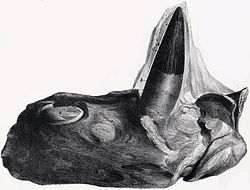Polyptychodon
| Polyptychodon Temporal range: Late Cretaceous,
| |
|---|---|

| |
| P. interruptus jaw with tooth | |
| Scientific classification | |
| Kingdom: | Animalia
|
| Phylum: | Chordata
|
| Class: | Sauropsida
|
| Order: | †Plesiosauria
|
| Suborder: | †Pliosauroidea
|
| Family: | |
| Subfamily: | †Brachaucheninae
|
| Genus: | †Polyptychodon Owen, 1841[1]
|
| Binomial name | |
| †Polyptychodon interruptus Owen, 1841[1]
| |
| Other species | |
| |
Polyptychodon (meaning 'shaped fin tooth') is a genus of pliosaurid found in Middle-Late Cretaceous marine deposits in southern England and Patagonia. It has been considered a nomen dubium in a 2016 review.[2]
History of discovery[]

The type species, P. interruptus is known from an isolated tooth from the Late Cretaceous Chalk Group of southern England.[1] Owen described a second nominal species of the genus, P. continuus, from an isolated tooth collected in the Hythe Formation of Maidstone, Kent. (The macronarian sauropod Dinodocus was mistakenly thought to be conspecific with P. continuus before it was correctly recognized as a dinosaur and not a plesiosaur.)
Numerous pliosaurid teeth and vertebrae from England and eastern France have been previously assigned to Polyptychodon, including isolated vertebrae from France which were misidentified as a sauropod.[3] Comparison between Albian-age isolated vertebrae from marine deposits in France and Kronosaurus suggested a size of approximately 7 metres (23 ft) for a Polyptychodon-like brachaucheniine pliosaurid.[3] However, a 2016 re-evaluation found Polyptychodon and its types species to be dubious, and that numerous remains from the Chalk Group in England that had been referred to the genus most likely represent different species of plesiosaurs, with some teeth possibly being referable to Polycotylidae.[2] Similar fossils of pliosaurs were found also in Czech Republic.[4]
The species Polyptychodon patagonicus (Ameghino, 1893), discovered in Argentina, has also been assigned to the genus, but it is unknown whether P. patagonicus belonged to Polyptychodon or not. According to a 2010 study, P. patagonicus is a nomen vanum and a nomen dubium.[5]
Misassigned species[]

Polyptychodon hudsoni (holotytpe, SMU 60313) was described from the Turonian-age Eagle Ford Formation of Dallas, Texas.[6][7]
See also[]
References[]
- ^ a b c Owen R. (1840-1845 [1841]). Odontography. Hippolyte Baillière, London, 655 p.
- ^ a b Madzia D. (2016) A reappraisal of Polyptychodon (Plesiosauria) from the Cretaceous of England. PeerJ 4:e1998 https://doi.org/10.7717/peerj.1998
- ^ a b Buffetaut E, Colleté C, Dubus B, Petit J-L. 2005. The "sauropod" from the Albian of Mesnil-Saint-Père (Aube, France): a pliosaur, not a dinosaur. Association Géologique Auboise, Bulletin Annuel, Sainte-Savine 26: 3-8.
- ^ "Druhohorní plazi v Čechách II". 13 July 2015.
- ^ J. P. O'Gorman and A. N. Varela. 2010. The oldest lower Upper Cretaceous plesiosaurs (Reptilia, Sauropterygia) from Southern Patagonia, Argentina. Ameghiniana 47(4):447-459 [P. Mannion/J. Tennant]
- ^ Welles SP, Slaughter BH. 1963. The first record of the plesiosaurian genus Polyptychodon (Pliosauridae) from the New World. Journal of Paleontology 37 (1):131-133.
- ^ "Plesiosaur Unearthed During Preliminary Excavation for the Dallas-Fort Worth International Airport"
External links[]
- Late Cretaceous plesiosaurs of Europe
- Cenomanian genus first appearances
- Turonian genus extinctions
- Fossil taxa described in 1841
- Taxa named by Richard Owen
- Nomina dubia
- Sauropterygian genera






